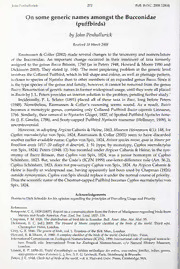
On Some Generic Names Amongst the Bucconidae (Puffbirds) PDF
Preview On Some Generic Names Amongst the Bucconidae (Puffbirds)
JohnPenhallurick 272 Bull.B.O.C.2008 128(4) On some generic names amongst the Bucconidae (puffbirds) by John Penhallurick Received 18March2008 Rasmussen & Collar (2002) made several changes to the taxonomy and nomenclature of the Bucconidae. An important change occurred in their treatment of taxa formerly assigned to the genus Bucco Brisson, 1760 (as in Peters 1948, Howard & Moore 1980 and Dickinson 2003). They stated (p. 104): The most perplexing problem at the generic level involves the Collared Puffbird, which inbill shape and colour, as well as plumage pattern, is closer to species ofNystalus than to other members ofan expanded genus Bucco. Since it is the type species ofthe genus and family, however, it cannotbe removed from the genus Bucco.Resurrectionofgenericnamesinformerwidespreadusage,untiltheywereallplaced inBuccoby L. Petersprovidesaninterimsolutionto theproblem,pendingfurtherstudy.' J. Incidentally, P. L. Sclater (1891) placed all of these taxa in Bucc, long before Peters (1948). Nonetheless, Rasmussen & Collar's reasoning seems sound. As a result, Bucco becomes a monotypic genus, containing only Collared Puffbird Bucco capensis Linnaeus, 1766. Similarly, their removal to Nystactes Gloger, 1827, ofSpotted Puffbird Nystactes tama- tia (J. F. Gmelin, 1788), and Sooty-capped Puffbird Nystactes noanamae (Hellmayr, 1909), is uncontroversial. However, inadoptingArgicus Cabanis & Heine, 1863,Museum Heineanum4(1): 148, for Cyphos macrodactylus von Spix, 1824, Rasmussen & Collar (2002) seem to have discarded anotherearlieravailablename: Cyphos vonSpix, 1824,Aviumspecies novae, quas in itinereper Brasiliam annis 1817-20 collegit et descripti, 1: 51 (type, by monotypy, Cyphos macrodactylus von Spix, 1824). Peters (1948: 12) has recorded underArgicus Cabanis & Heine, in the syn- onymy of Bucco Brisson, that Cyphos von Spix, 1824, was a junior homonym of Cyphus Schonherr, 1823. But, under the Code's (ICZN 1999) one-letter-difference rule (Art. 56.2), Cyphus Schonherr, 1823, does not pre-occupy Cyphos von Spix, 1824. As Argicus Cabanis & Heine is hardly in widespread use, having apparently last been used by Chapman (1926) outsidesynonymies, Cyphos vonSpixshould replaceitunder thenormalcourseofpriority. ThusthescientificnameoftheChestnut-cappedPuffbirdbecomesCyphosmacrodactylusvon Spix, 1824. Acknowledgements ThankstoDickSchoddeforhisopinionregardingtheprinciplesofPrevailingUsageandPriority. References: Bonaparte,C.L. 1838[1837].ReportonacommunicationfromthePrinceofMusignanoregardingbirdsfrom MexicoandSouthAmerica. Proc. Zool. Soc. Lond. 1837: 119. Chapman,F.M. 1926.Thedistributionofbird-lifeinEcuador. Bidl.Amer.Mus. Nat. Hist.55. Dickinson, E. C. (ed.) 2003. The Howard & Moore complete checklist of the birds of the world. Third edn. ChristopherHelm,London. Gray,G.R. 1846. Thegeneraofbirds,vol. 1.TrusteesoftheBrit. Mus.,London. Howard,R. &Moore,A. 1980.Acompletechecklistofthebirdsoftheworld.OxfordUniv. Press. InternationalCommissiononZoologicalNomenclature(ICZN). 1999.Internationalcodeofzoologicalnomencla- ture. Fourth edn. International Trust for Zoological Nomenclature, c/o Natural History Museum, London. Lesson, R. P. 1830-31. Trade d'ornithologieou tableau methodiquedes ordres, sous-ordres,families, tribus,genres, sous-genreset racesd'oiseaux [...],livr.3. F.G. Levrault,Paris,Strasbourg&Brussels. Peters,J.L. 1948. Check-listofbirdsoftheworld,vol. 6.HarvardUniv. Press,Cambridge,MA. JohnPenhallurick 273 Bull. B.O.C.2008 128(4) Rasmu&ssSearng,atPa.l,C.J.&(eCdos.l)laHra,nNd.boJ.ok20o0f2.theFabmiridlsyofButhcecowonrildda,evo(lp.uf7f.bLirydnsx).EPdpic.i1o0n2s-,13B8aricneldoenla.Hoyo,J., Elliott,A. Sclater, P. L. 1891. Catalogueofthebirds in theBritishMuseum,vol. 19. Trustees ofthe Brit. Mus. (Nat. Hist.), London. Wagler,J.G. 1827. SystemaAvium.J.G.Cotta,Stuttgart&Tubingen. Address:86BingleyCrescent,Eraser,ACT,Australia,e-mail:[email protected] ©BritishOrnithologists'Club2008 The gender of genera ending in -oenas by Normand David & Steven M. S. Gregory Received30April2008 Many avian genus-group names have been formed from the feminine Greek word oivag [wild pigeon]. Some, like Oena, Reinwardtoena and Turacoena, are Latinised with a change ofending [-ac, to -a], here indicative ofthe feminine gender (ICZN 1999, Art. 30.1.3) thatis correctlyreflected by current combinations (Peters 1937, Dickinson2003). Names ending in -oenas (this is not the transliterated -oinas, to be treated under Art. 30.1.2) are also Latinised,but this ending is not indicative ofa particular gender underArt. 30.1.3. In such cases, the gender mustbe determined under Art. 30.1.4.2: a name that ends in -oenas is masculine unless its author, in the original work, stated that it is feminine or combined itwith an adjectival species-group name in the feminine form. Table 1 shows the grammaticalgenderofthe genericnamesendingin-oenas thatareto be encountered within Peters (1937), Wolters (1975) and Dickinson (2003). A considerable number ofother avian generic names endingin -oenas are tobe found as subgenera orjun- ior synonyms in other works, but they are not treated here. TABLE 1 Genderofgenericnamesendingin-oenasasfoundinPeters(1937),Wolters (1975),andDickinson(2003). Genus-groupname Originalcombination Gender AlectroenasG.R.Gray, 1840 A.franciae Masc. AlopecoenasSharpe, 1899 A. hoedti Masc. CaloenasG.R.Gray, 1840 C. nicobarica Fem. ChloroenasReichenbach, 1853 C. monilis Masc. CompsoenasRiley, 1921 C. radiata Fem. CoryphoenasWardlawRamsay, 1890 C. crassirostris Masc. JanthoenasReichenbach, 1853 janthina Fem. J. LepidoenasReichenbach, 1853 L. speciosa Fem. LithoenasReichenbach, 1853 L. livia Fem. NesoenasSalvadori, 1893 N. mayeri Masc. NotioenasRidgway, 1915 Nocombination Masc. OenoenasSalvadori, 1893 Nocombination Masc. PatagioenasReichenbach, 1853 P. leucocephala Fem. StarnoenasBonaparte, 1838 S. cyanocephala Fem. TaenioenasReichenbach, 1853 T.albitorques Masc. ZonoenasReichenbach, 1853 Z. miilleri Masc.
